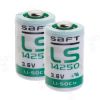Extech 3-Axis G-Force USB Datalogger
Features
- USB interface for easy set-up and data download
- Records and times 3-axis shock and peaks
- Selectable data sampling rate: 50ms to 24 hours
- Free ground shipping
- Expedited repair and warranty service
- Lifetime technical support
- More
The Extech VB300 can measure and record shock and vibration (acceleration) readings over its +/-18g measurement range. This device will record 3-axis g-force and related peaks to provide a history of shock and vibration conditions. The real time clock provides time stamps for all data.
The user can easily configure the logging rate, high/low alarm and start-mode, and download the stored data by plugging the VB300 into a PC's USB port and running the supplied PC software. Measurement data can be plotted, printed and exported for use with other applications such as word processors and spreadsheets. The data logger is supplied with a long-life 1000 hour lithium battery.
The VB300 memory uses a 4MB Flash device that can hold 85,764 peak acceleration samples and 210 freefall samples. Additional features include:
- Selectable X-, Y-, Z-axis or any combination (via software)
- Selectable data sampling rate: 50ms to 24 hours
- Datalogs 85,764 peak acceleration samples
- Manual and Programmable start modes
- User-programmable record threshold
- Long battery life - 1000 hours
- Sensor type: MEMS semiconductor
- Acceleration sampling rate: 200Hz
- Acceleration range: +/-18g
- Acceleration resolution: 0.00625g
- Acceleration accuracy: +/-0.5g
- Bandwidth: 0 to 60Hz
- Sampling rate: 500 ms to 24 hours
- Memory: 4Mbit Flash; 85764 samples (approx. 28588 samples/axis)
- Data format: time stamped peak acceleration, average and peak vector sum
- Dimensions: 3.7x1.1x0.8" (95x28x21mm)
- Weight: 1oz (20g)
- (1) USB Datalogger
- (1) Magnetized/bolt-on mounting base
- (1) 3.6V Lithium battery
- (1) Copy of Windows compatible analysis software
In The News
From Paddles to Phytoplankton: Studying Vermont’s Wildest Lakes
For six months of the year, Rachel Cray, a third-year PhD student at the Vermont Limnology Laboratory at the University of Vermont, lives between a microscope and her laptop, running data. For the other six months, she is hiking and canoeing four of Vermont’s lakes, collecting bi-weekly water samples. Cray studies algal phenology across four lakes in Vermont, US, that have low anthropogenic stress—or in other words, are very remote. Funded by the National Science Foundation Career Award to Dr. Mindy Morales, the lakes Cray researches part of the Vermont Sentinel Lakes Program, which studies 13 lakes in the area and, in turn, feeds into the Regional Monitoring Network, which operates in the Northeast and Midwest US.
Read MoreReimagining Water Filtration: How Monitoring and Science Enhance FloWater Filtration Systems
Over 50% of Americans think their tap water is unsafe , according to the Environmental Working Group (EWG). Other recent surveys have found that number to be as high as 70% of persons surveyed. Whether due to increased public awareness of water quality issues or confusion about how municipal water sources are regulated, there is a clear distrust of tap water in the United States. According to industry expert Rich Razgaitis, CEO and co-founder of the water purification company FloWater, this issue creates a damaging cycle. Razgaitis explained that the health and environmental problems associated with contaminated water aren’t the only issues. As people become increasingly aware that some tap water is unsafe, they resort to bottled water.
Read MoreMonitoring New Hampshire’s Aquatic Ecosystems: Continuous Data Collection in the Lamprey River Watershed
New Hampshire’s aquatic ecosystems provide a range of ecosystem services to the state and region. Resources and services like clean water, carbon storage, climate regulation, nutrient regulation, and opportunities for recreation all depend on New Hampshire’s aquatic ecosystems remaining healthy. Jody Potter, an analytical instrumentation scientist at the University of New Hampshire (UNH), is studying these aquatic ecosystems in hopes of developing an improved understanding of ecosystem services and their interactions with climate change, climate variability, and land use changes. [caption id="attachment_39799" align="alignnone" width="940"] Aquatic sensors in the Merrimack River in Bedford, NH, with I-293 in the background.
Read More








